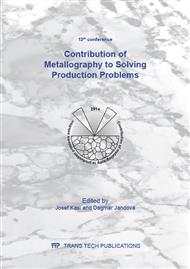p.9
p.17
p.23
p.38
p.47
p.59
p.66
p.72
p.79
Effect of Sample Thickness on Slab Surface Zone Toughness in IF and Microalloyed Steels
Abstract:
The aim of this work was to analyze the effect of sample thickness on toughness of the slab surface zone at ambient temperature in IF and microalloy steels. Transitional slabs with different pulling rates at the start and the end of the slab were used as well as slabs with standard pulling rates. Samples of standard size 10x10x55 mm and also non-standard size 5x10x55 mm were used for Charpy impact testing. It was confirmed that higher toughness values were found in thin non-standard size samples (5x10x55 mm), or more precisely for a larger portion of non-standard samples with toughness values higher than 50 J.cm-2. Using non-standard size samples confirmed the distinct stability of toughness values, as well as their smaller spread between minimum and maximum values. The transitional slabs had very distinct and non-uniform spread of toughness values across the slab width. This suggests greatly deteriorated quality of these slabs. During stable casting of TiNb microalloyed steel at the standard conventional higher slab pulling rate, uniform toughness was confirmed across the whole slab width in both sample types.
Info:
Periodical:
Pages:
47-55
Citation:
Online since:
May 2015
Keywords:
Price:
Сopyright:
© 2015 Trans Tech Publications Ltd. All Rights Reserved
Share:
Citation:


